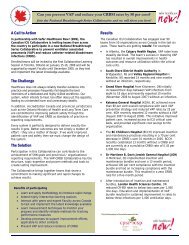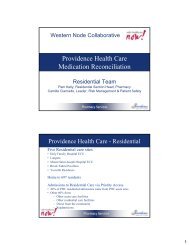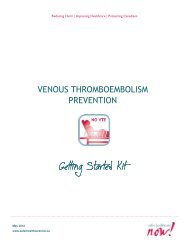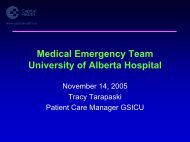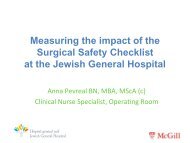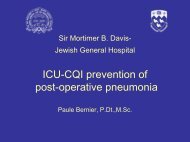VAP Getting Started Kit - Safer Healthcare Now!
VAP Getting Started Kit - Safer Healthcare Now!
VAP Getting Started Kit - Safer Healthcare Now!
You also want an ePaper? Increase the reach of your titles
YUMPU automatically turns print PDFs into web optimized ePapers that Google loves.
<strong>Safer</strong> <strong>Healthcare</strong> <strong>Now</strong>! Prevent Ventilator Associated Pneumonia <strong>Getting</strong> <strong>Started</strong> <strong>Kit</strong><br />
The potential for harm associated with HOB elevation has been addressed in the published<br />
literature. Pressure ulcers are more likely to occur at higher HOB elevation in critically ill<br />
patients 46 as well as in normal subjects. 47 Of note is that the Wound, Ostomy and Continence<br />
Nurses Society recommends maintaining the HOB at 30 0 elevation for supine positions. 48 Other<br />
factors similarly impede bedside practitioners’ adherence to higher degrees of HOB elevation 49<br />
decreased systolic blood pressure, SOFA score 50 , sliding down the bed, skin shearing, insomnia,<br />
inability to accurately estimate back rest elevation. 51 In order to address these issues, the<br />
American Association of Critical Care Nurses issued a Practice Alert for <strong>VAP</strong> prevention in 2004<br />
which was revised in 2007 to include evidence-based Practice Alert Statements and tools. 52<br />
A systematic review on the benefits and disadvantages of semi-upright position in ventilated<br />
patients was done by a European expert panel. 53 Based on their results, they recommended that<br />
ICU caregivers “elevate the head of the bed of mechanically ventilated patients to a 20 to 45°<br />
position and preferably in a ≥30° position as long as it is does not pose risks and conflicts with<br />
other nursing tasks, medical interventions or with patients’ wishes”.<br />
It thus appears that:<br />
• the optimal semi-recumbent HOB elevation position that reduces the development of<br />
aspiration and <strong>VAP</strong>, while deriving the least risk to patients is not known.<br />
• the level of evidence for the use of lower HOB elevation to prevent the most<br />
controversial complication - sacral pressure ulcers- is not as strong as that for HOB<br />
elevation to prevent aspiration and <strong>VAP</strong>. 54<br />
We conclude that until further evidence becomes available, patients without contraindications<br />
to HOB elevation should be kept at 45°, and when this is not possible, keeping the head of the<br />
bed above 30° should be considered. In all cases, the exact angle strategy is determined on a<br />
patient-to-patient basis according to individual patient needs.<br />
What changes can we make that will result in improvement?<br />
Hospital teams across Canada and the United States have developed and tested process and<br />
system changes that allowed them to improve performance on elevation of HOB. These<br />
measures support the implementation of the <strong>VAP</strong> bundle. Some of these changes are:<br />
• Identify local implementation challenges (e.g. insufficient awareness of the benefit of<br />
the 45 0 backrest elevation, disagreement about who is responsible for patients' bed<br />
positioning, difficulties in enabling and reinforcing such strategies) to tailor improvement<br />
strategies to the environment in your ICU. 55<br />
• Be aware of other practical challenges in maintaining head of bed elevation throughout<br />
the day and night such as: 1) patients sliding down the bed if overly elevated, 2) bed<br />
often needs to be lowered for procedures such as line placement, bathing, wound care,<br />
patient turns, etc., 3) caregivers forget to re-elevate the head of the bed following these<br />
procedures.<br />
• Determine what constitute valid contraindications for semi-recumbency in your ICU<br />
population (e.g. recent spine surgery or spinal cord trauma, abdominal wound, unstable<br />
pelvic fracture, mod-high-grade sacral ulcer, hemodynamic instability, increased<br />
June 2012 14



